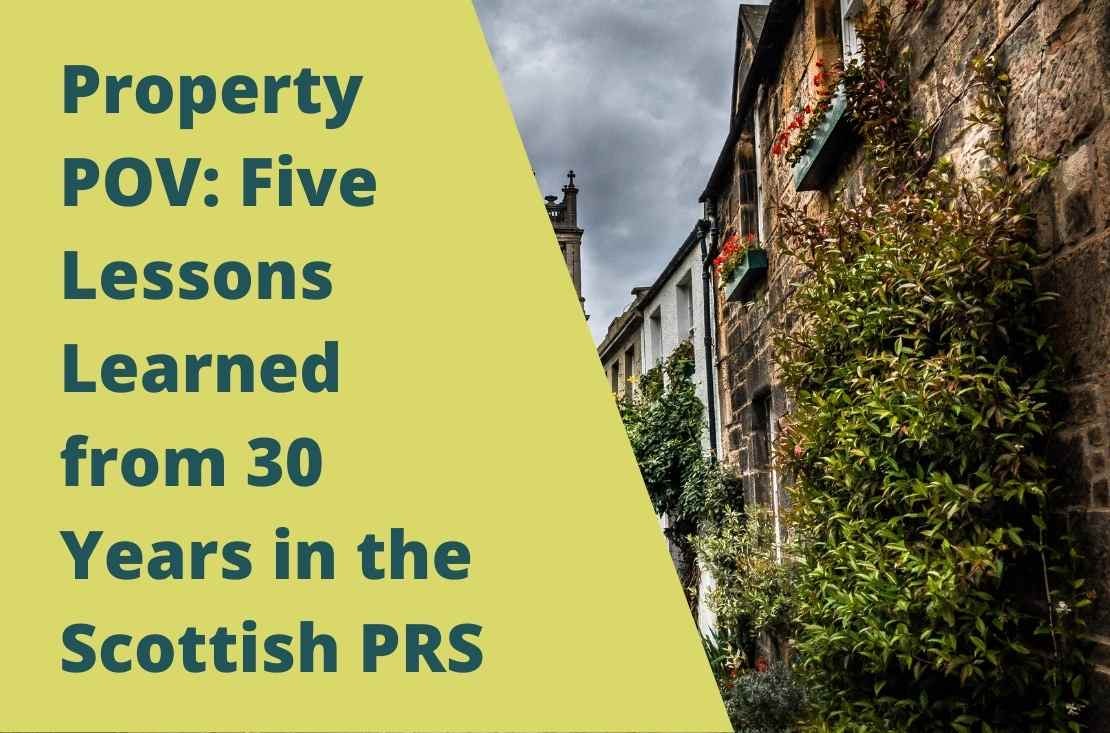Hindsight is a wonderful thing, especially when it comes to property.
It’s 30 years since the Scottish PRS really took off, and as I have been a property professional for almost as long, it seems like a good time to share some observations with you.
Despite clear evidence of landlords caring for their tenants, private sector landlords do not enjoy a good reputation. The perception seems to be that rents are on the high side and this is a major factor in contributing to the housing crisis.
I hope you’ll agree that it’s time to challenge the notion that Scotland’s housing crisis is being caused by greedy landlords in the PRS, especially when there are so many other factors at play.
Let’s take a look at the last 30 years and see what lessons can be learned. Who knows, maybe that will set the record straight?
What we’ve learned about the Scottish PRS in the last 30 years
I’m sure that you’re as fed up with hearsay and conjecture as I am regarding the landlord’s role in the changing face of the PRS, so let’s take a look at the facts:
There are many more council tenants in the PRS than in 1992
Data from the SHS (Scottish Household Survey) in 2018 established that the PRS is three times the size it was less than 20 years previously. Census figures between 2001 and 2011 alone make for interesting reading.
In 2001 the census recorded that there were 147,251 households in the Scottish PRS housing sector. By 2011, that figure had almost doubled to 294,892 and, according to the SHS, was standing at 340,000 by 2018.

It’s important to note, however, that disillusioned landlords who are leaving the private sector mean that this figure is shrinking rapidly. As this article by Propertymark shows, the facts make for alarming reading.
Census records between 2001 and 2011 also show that the amount of households living in council accommodation fell from 514,980 to 312,745. It’s not a stretch to imagine that a significant proportion of those former council tenants now live in the PRS.
At any rate, the fact remains that there is a housing shortage at the same time that the population is growing, and private sector landlords are taking up the slack.
The impact of Right to Buy can’t be ignored
Council housing and housing association stock has been significantly depleted by the now-defunct Right to Buy policy, making it much harder to keep up with rising demand.
Right to Buy was abolished in Scotland in 2016, so it was very much active between the Census years of 2001 and 2011. I’m not suggesting that Right to Buy is entirely responsible for the housing crisis but it can’t be ignored as a contributing factor.
Almost 495,00 homes across social and council housing were sold off in the RTB period (1980 – 2015) This is a staggering figure, and a sobering one when you consider how difficult it continues to be to replace them.
The Scottish Government pledged in 2016 to build 50,000 social homes across the lifetime of the Parliament, but as you can see in this article that target was not met.
The pledge was repeated in 2021, but it seems like a drop in the ocean, don’t you think?

There are over 43,000 homes lying empty across the country
Efforts are now being stepped up to bring some of Scotland’s 43,766 empty homes, of which 28,000 have been empty for more than a year – back into public use. This figure of 43,766 represents an 186% increase on the 2005 total of 15,766.
Progress is slow, with only 6,000 homes restored over the past decade. This is understandable, as not every empty home will be suitable for renovation due to a number of complex factors.
Andy Moseley, Policy and Projects Manager of the Scottish Empty Homes Partnership is only too aware of the task ahead, but has pledged to highlight the issue in order to make empty homes part of the solution rather than the problem.
As he states in a recent article: “Bringing empty homes back into use can help drive down the carbon emissions caused by housing and housing construction. Where a home is retrofitted to improve energy performance, it can also help to drive down the cost of heating and reduce operational carbon emissions.
“By working to support renovation of suitable empty homes and returning them back to use, local authorities can help to breathe new life into old homes, improving the quality of housing stock and improving the quality of life in the communities with empty stock.”
This is proof that with the right priorities, things can happen at a faster pace when it comes to housing. I recently read that the Scottish Government is making 200 empty properties available within 6 weeks. Perhaps this will set a trend?
Planning for housing needs to be a priority
As I’ve stated, council house tenant figures have shrunk while PRS figures have grown, suggesting that it’s private landlords who have absorbed the shortages in social housing. Figures from 2018-19 also show huge variations in housing supply across Scotland:
In Glasgow, 51% of new housing supply during this period was housing association, with Edinburgh at just 11% in comparison and 6% local authority new build. Furthermore, 75% of new housing supply in Edinburgh in 2018-19 was private sector new builds.
As this article shows, housing supply is yet to reach pre-Covid levels, which themselves don’t compare favourable to 2007-2008 levels; 2019-20 saw 23,047 homes built, refurbished or converted, compared to 27,594 in 2007-08.
If local authorities don’t prioritise housing through their local development plans (as appears to be in the case in Edinburgh) then planners have no obligation to protect land that should be set aside for housing.
Developers can then build more lucrative student accommodation and hotels with the result that renters seeking housing are forced into the struggle of trying to find a home while competing with fellow tenants in the same, increasingly shallow pool of properties.
Advice from the property pros

I hope this blog has made for some interesting reading. At Portolio we see a lot of the prevailing narrative that says landlords are thoughtless, greedy and responsible for the housing crisis, and I thought it was time to challenge that.
As you can see, it’s pointless to blame just one party for the shortage of good quality, affordable housing when there are so many complex factors at place.
There are historical factors such as ‘Right to Buy’ and the continuing fallout from the pandemic, of which we still haven’t seen the full extent.
Then you have legislation heavily weighted in favour of the tenant which in itself is, of course, a good thing. However, tenant representation should be equally balanced with similar representation for landlords but this seems unlikely to happen.
The net effect of landlords feeling unsupported and under-represented in local government means that many are disillusioned and withdraw from the PRS, further exacerbating the problem.
The answer clearly won’t be found by negative bias and blame, but by more homes being built, including substantial numbers of affordable and social housing. That’s just the start.
Returning empty homes to full use and underpinning all this with a PRS which works and is supported by the Government is what is needed if there is to be a means to adequately address the housing crisis in Scotland.
In summary…
Thanks for taking the time to read, and hopefully I’ve managed to provide some useful insight into the Scottish PRS based on my experience of the past 30 years.
What’s your opinion on the way forward for landlords within the PRS? We’d love to hear your thoughts, so feel free to join the conversation below.
And, if you have any questions for us about anything Scottish PRS-related, we’re always happy to have a chat, so don’t hesitate to get in touch!

Written by Chris Wood, MD & Founder of Portolio
Get in touch on 07812 164 842 or email [email protected]


Comments